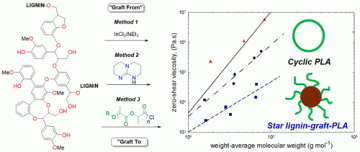
Despite numerous accounts of biobased composite materials through blending and copolymerization of lignin and other polymers, there are no systematic studies connecting the synthetic methodology, molecular structure, and polymer topology with the rheological properties of these materials. In this report lignin-graft-poly(lactide) copolymers are synthesized via three routes (indium and organocatalyzed “graft-from” methods as well as a “graft-to” method) and the resulting reaction products (shown to include linear PLAs, cyclic PLAs, and star-shaped lignin-graft-PLA copolymers) are investigated using chemical and rheological methods. The topology of the products of the graft-from methods is affected by the initial lignin concentration; polymerizations with low lignin loading generate cyclic PLAs, which can be identified by 10-fold lower viscosities compared to linear PLAs of the same molecular weight. Under higher lignin loadings, star-shaped lignin-graft-PLA copolymers are formed which show viscosities 2 orders of magnitude lower than those of comparable linear PLAs. Rheological studies show that cyclic PLAs lack a well-defined rubber plateau, whereas star-shaped lignin-graft-PLAs lack a significant G′ to G′′ cross-over. The rheological results coupled with thermogravimetric analysis give an indication to the structure of star-shaped lignin-graft- PLA copolymers, which are estimated to contain a small lignin core surrounded by PLA segments with molecular weights from 2.0 to 20 kg mol−1.